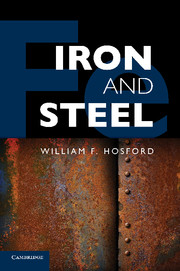Book contents
- Frontmatter
- Contents
- Preface
- 1 General Introduction
- 2 Early History of Iron and Steel
- 3 Modern Steel Making
- 4 Constitution of Carbon Steels
- 5 Plastic Strength
- 6 Annealing
- 7 Deformation Mechanisms and Crystallographic Textures
- 8 Substitutional Solid Solutions
- 9 Interstitial Solid Solutions
- 10 Diffusion
- 11 Strain Aging
- 12 Austenite Transformation
- 13 Hardenability
- 14 Tempering and Surface Hardening
- 15 Low-Carbon Sheet Steel
- 16 Sheet Steel Formability
- 17 Alloy Steels
- 18 Other Steels
- 19 Stainless Steels
- 20 Fracture
- 21 Cast Irons
- 22 Magnetic Behavior of Iron
- 23 Corrosion
- Appendix I Physical Properties of Pure Iron
- Appendix II Approximate Hardness Conversions and Tensile Strengths of Steels
- Index
- References
7 - Deformation Mechanisms and Crystallographic Textures
Published online by Cambridge University Press: 05 May 2012
- Frontmatter
- Contents
- Preface
- 1 General Introduction
- 2 Early History of Iron and Steel
- 3 Modern Steel Making
- 4 Constitution of Carbon Steels
- 5 Plastic Strength
- 6 Annealing
- 7 Deformation Mechanisms and Crystallographic Textures
- 8 Substitutional Solid Solutions
- 9 Interstitial Solid Solutions
- 10 Diffusion
- 11 Strain Aging
- 12 Austenite Transformation
- 13 Hardenability
- 14 Tempering and Surface Hardening
- 15 Low-Carbon Sheet Steel
- 16 Sheet Steel Formability
- 17 Alloy Steels
- 18 Other Steels
- 19 Stainless Steels
- 20 Fracture
- 21 Cast Irons
- 22 Magnetic Behavior of Iron
- 23 Corrosion
- Appendix I Physical Properties of Pure Iron
- Appendix II Approximate Hardness Conversions and Tensile Strengths of Steels
- Index
- References
Summary
Slip and Twinning Systems
The direction of slip in iron as in all body-centered cubic (bcc) metals is <111>. This is the direction of the shortest repeat distance in the bcc lattice. Slip can occur on any plane containing a <111> direction. The critical stress for slip is lowest for the {110} plane and highest for the {112}, the difference increasing as the temperature decreases. There is also an asymmetry to slip on {112}. The shear stress for slip is least when the direction is the same as for twinning and highest in the anti-twinning direction. See Figure 7.1.
For iron and all bcc metals, the twinning direction is <111>, and the twinning plane is {112}. The twinning shear strain is 1/√2 = 0.707. Twins, called Neuman bands, are very narrow and occur only during deformation at low temperatures or high strain rates. At 4.2 K, the critical shear stress for twinning is about 520 MPa. Twinning normally contributes little to the overall deformation.
- Type
- Chapter
- Information
- Iron and Steel , pp. 66 - 79Publisher: Cambridge University PressPrint publication year: 2012



